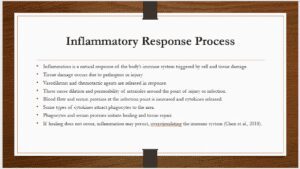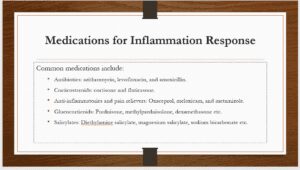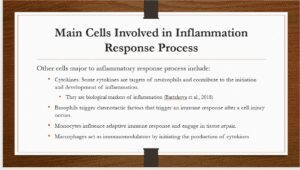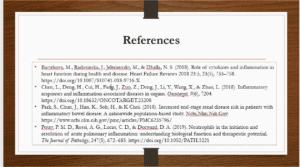Acute Inflammatory Response

Do you need an original copy oft the “Acute Inflammatory Response “ ? Contact us.

Various medications can be used for the management of inflammatory responses. The most commonly used medications include antibiotics, corticosteroids, anti-inflammatories and pain relievers, glucocorticoids, and salicylates. The common antibiotics for inflammatory response include azithromycin, levofloxacin, and amoxicillin, among others. Further, common corticosteroids include cortisone and fluticasone, while the major anti-inflammatories and pain relievers used include oxaceprol, meloxicam, and metamizole. The inflammatory response medications belonging to the class glucocorticoids include prednisone, methylprednisolone, and dexamethasone, while common salicylate includes diethylamine salicylate, magnesium salicylate, and sodium bicarbonate. The choice of medications for inflammatory response is based on cause, region affected, and severity.
Neutrophils are the main phagocytes that are involved in the inflammatory response process. Neutrophils are the main cells in the inflammatory response process because they contain granules filled with cell-destroying enzymes and proteins that are essential in protecting the tissues from infections. This means they are responsible for initiating and resolving inflammation and the repair of damaged tissue after an infection or an injury (Potey et al., 2019). These cells are readily available in the blood, but in cases of extensive infection, neutrophils can be generated from immature cell forms in the bone marrow (Park et al., 2018). Although neutrophils are the main cells during inflammation, their movement to injured tissues is negotiated by chemicals from other cells that initiate the inflammatory response. There are other cells that are also involved after the continued or repeated acute inflammation and transition to chronic inflammation.
Various other cells are also majorly involved in the initiation, maintenance, and resolution of the inflammatory response. These include cytokines, basophils, monocytes, and macrophages. These cells create the chemotactic factors that lead to neutrophil concentration around injured tissue. Cytokines play various roles throughout the inflammatory response. They are viewed as biological markers of inflammation (Bartekova et al., 2018). Some types of cytokines are targets of neutrophils and contribute to the initiation and development of inflammation. On the other hand, macrophages act as immunomodulators by initiating the production of cytokines, whereas basophils trigger chemotactic factors that initiate an immune response after a cell injury occurs. Additionally, the monocytes, which appear later after the tissue injury and the action of neutrophils, influence adaptive immune response and engage in tissue repair.
ORDER A PLAGIARISM-FREE PAPER HERE
We’ll write everything from scratch
Question
Describe the inflammatory response process
Acute Inflammatory Response
, medications used in the medical field to attack this process, and the main cells involved in this process.





